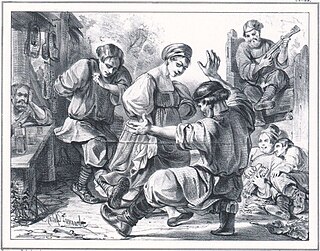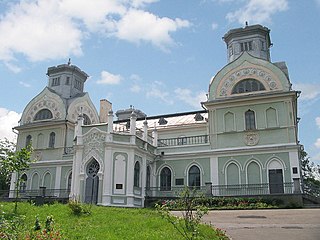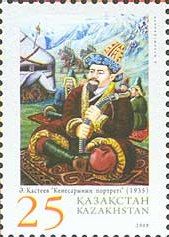
Circassia, also known as Zichia, was a country and a historical region in the North Caucasus along the northeast shore of the Black Sea. It was conquered and occupied by Russia during the Russo-Circassian War (1763–1864), after which 90% of the Circassian people were either exiled from the region or massacred in the Circassian genocide.

Circassians, also called Cherkess or Adyghe, are an indigenous Northwest Caucasian ethnic group and nation native to the historical country-region of Circassia in the North Caucasus. As a consequence of the Circassian genocide perpetrated by the Russian Empire in the 19th century during the Russo-Circassian War, most Circassians were exiled from their homeland in Circassia to modern-day Turkey and the rest of the Middle East, where most of them are today. In the early 1990s, the Unrepresented Nations and Peoples Organization estimated that there are as many as 3.7 million Circassians in diaspora in over 50 countries.

Konstantin Nikolaevich Leselidze was a Colonel-General and Hero of the Soviet Union who distinguished himself at the North, Transcaucasus and Ukrainian front during World War II. He was also the elder brother of Viktor Nikolaevich Leselidze

Tropak or trepak is a traditional Russian and Ukrainian folk dance.

Georgy Filippovich Baydukov was a Soviet test pilot, Hero of the Soviet Union (1936), writer and hunter.
The Vainakh peoples of the North Caucasus were Islamised comparatively late, during the early modern period, and Amjad Jaimoukha (2005) proposes to reconstruct some of the elements of their pre-Islamic religion and mythology, including traces of ancestor worship and funerary cults. The Nakh peoples, like many other peoples of the North Caucasus such as Circassians, practised tree worship, and believed that trees were the abodes of spirits. Vainakh peoples developed many rituals to serve particular kinds of trees. The pear tree held a special place in the faith of Vainakhs.

Otomārs Aleksandrs Oškalns was a prominent Latvian communist and partisan fighter.

The Natukhaj, Natuqwai or Natukhai are one of the twelve major Circassian tribes, representing one of the twelve stars on the green-and-gold Circassian flag. Their areas historically extended along the Black Sea coast from Anapa in the north to Tsemes Bay in the south and from the north side of the mountains to the lower Kuban River.
The Mamkhegh or Mamheg were one of the twelve major Circassian tribes, representing one of the twelve stars on the green-and-gold Circassian flag.

Kazimir Stanislavovich Barantsevich was a Russian writer and poet, who also used the pseudonym Sarmat.

The Lopukhin family was a noble family of the Russian Empire, forming one of the branches of the Sorokoumov-Glebov family.

Alexander Ignatyevich Sedyakin was a Soviet division commander and Komandarm 2nd rank. He was born in St. Petersburg, which was then the capital of the Russian Empire. He fought in the Imperial Russian Army in World War I before going over to the Bolsheviks. He fought against Finland and the pro-Finnish separatists of the Republic of East Karelia in East Karelia. On November 11, 1935, he was one of the 10 people made Komandarm 2nd rank. He received the Order of the Red Banner twice.

Ivan Ivanovich Gorbunov-Posadov was a Russian, Soviet writer, poet, editor and publisher.

The history of metallurgy in the Urals stands out to historians and economists as a separate stage in the history of Russian industry and covers the period from the 4th millennium BC to the present day. The emergence of the mining district is connected with the history of Ural metallurgy. The geography of the Ural metallurgy covers the territories of modern Perm Krai, Sverdlovsk Oblast, Udmurtia, Bashkortostan, Chelyabinsk Oblast and Orenburg Oblast.
The Khegayk or Shegayk were one of the Circassian tribes. They were completely exterminated in the Circassian genocide following the Russo-Circassian War. None were recorded to have survived. In some sources, they are also mentioned under the name "Shegayk".

The siege of Anapa or the storming of Anapa was a siege that took place on June 22 (O.S) 1791 when the Russian Empire attacked the Turkish-regulated Anapa fort in Circassia as part of the Russo-Turkish War and the Russo-Circassian War.

Donetsk Metallurgical Plant also called Donetsk Iron and Steel Works is an enterprise of Donetsk, Ukraine. It is a ferrous metallurgy enterprise that is located in the Leninskyi district of Donetsk.
Circassians is a broad ethnonym of the Turkic origin, which in Russia, Turkey and Persia used to be, and in the case of Turkey is now, applied to peoples of different ethnicities living on the North Eastern and Eastern shores of the Black Sea, and in the Northern Caucasus.

Kenesary Qasymov, or Kenesary Qasymuly, Kenesary Khan was the last khan of the Kazakh Khanate, grandson of Ablai Khan, from the clan of Genghisid-Tore.















